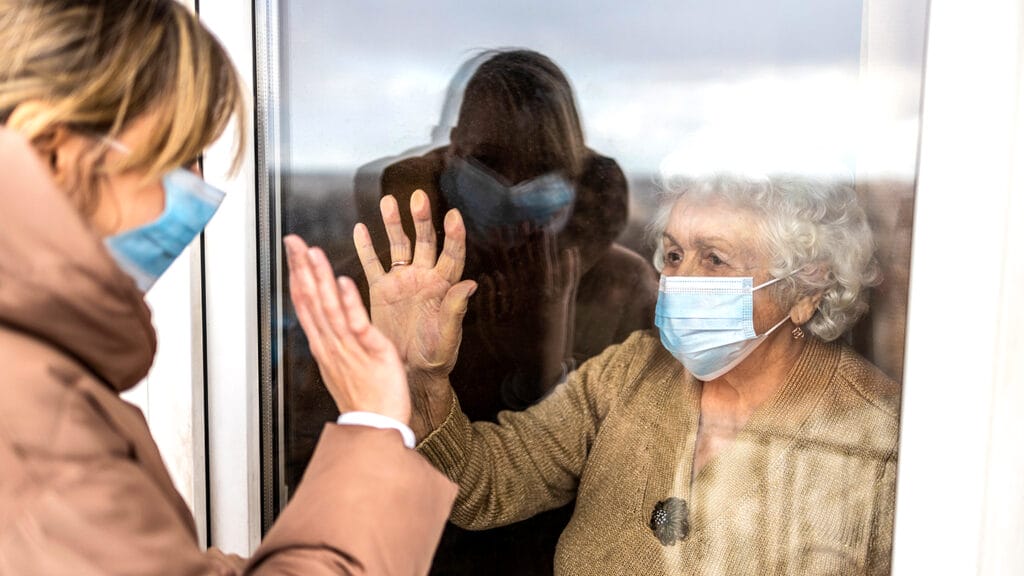
Constantly changing guidelines, fractured communication and being abruptly cut off from loved ones in nursing and residential care homes had a “profound” effect on the physical and mental health of family members during COVID-19 pandemic lockdowns, according to a new study.
Researchers from the University of South Carolina and Western University in Ontario, Canada, interviewed 21 family members of nursing and residential care home residents in Canada to explore their perceptions of the effects that lockdowns had on social connectedness to their loved ones.
The results, published recently in the Canadian Journal on Aging, highlight the important role of social connection in the health and well-being of older adult residents — and their family members, according to the authors. The researchers said that as communities and residents worked through the complexities of the pandemic, family members, too, were affected by limited communication and their inability to engage in meaningful relationships with their loved ones “from whom they were cut off with no warning or preparation.”
Lead author Anna Garnett, RN, PhD, an assistant professor with the Arthur Labatt Family School of Nursing at Western University, told McKnight’s Senior Living that the findings could apply to senior living as well as other congregate living settings for older adults.
“I think key takeaways for non-nursing home senior living providers would be highlighting the importance of psychosocial well-being of both those living in these settings, as well as their family members,” Garnett said. “Our research showed even across a small sample of caregivers/family members that they lived in a more or less chronic state of fear and worry about the well-being of those living in care throughout those early waves of COVID-19.”
Key themes that emerged from the interviews with families included lacking connections, which threatened mental, emotional and physical health; navigating trust in the unknown; feelings of stress and anxiety for family members; and adopting technology.
According to the results, older adults reported decreases in sleep quality and activity level, as well as sadness, loneliness, fear and frustration. Family members reported feelings of loss, sadness, frustration, grief and distress over the inability to visit their loved ones.
Families believed that a lack of communication regarding the well-being of long-term care home residents resulted in feelings of disconnection from their care and experiencing challenging relationships with staff. They said that the information they received felt impersonal and infrequent, leaving them concerned and with questions about the health, safety and well-being of their loved ones.
“The intermittent lapses in communication, receipt of conflicting messages and challenges experienced by family member participants when trying to engage with older adults and staff in long-term care had profound impacts on their health and well-being,” the authors wrote. “An increase in regular communication between family members and long-term care staff may have helped foster a relationship built on trust and helped reassure family members that their older adult family member was receiving good care.”
Family member participants said they struggled to remain up to date on frequently changing safety requirements and believed that these measures were detrimental to their relationships with loved ones in long-term care. Personal protective equipment, rapid testing and constraints on length of visits all made it challenging for families to maintain quality relationships with their loved ones, they said. They also said they experienced difficulties scheduling visits.
Essential caregivers
As subsequent waves of the pandemic progressed, family members in some areas were recognized as “essential caregivers,” a status that granted them wider access to provide physical, social and emotional care and support to their loved ones who lived in long-term care, the researchers said.
But the authors noted that labeling all family members as “visitors” devalued their role as caregivers and failed to acknowledge that unpaid caregivers are integral to the health and emotional well-being of older adults living in long-term care settings. Policies and procedures related to the role of essential caregivers, particularly regarding supporting physical care and social connectedness, are “vital” to both long-term care residents and their family members, according to the authors.
Future research, the investigators said, should explore a variety of approaches to embed essential caregivers within long-term care and create a balance between physical safety and the valuable role that family members have in the day-to-day care of long-term care residents.
Technology challenges
Government-imposed social distancing mandates required family members and residents to find alternative approaches for social connectedness, the authors noted. Outdoor and window visits, and using staff members as go-betweens for arm’s-length visits, were “inadequate” in meeting the social connectedness needs of older adults and their families, according to survey responses.
Although many family members turned to technology for assistance, it was not without its challenges either. Technology offered benefits, but family-member survey participants said that devices such as phones and iPads could not replace in-person visits. They also shared factors that made using technology in place of in-person visits challenging, such as cognitive limitations, hearing problems and trying to use technology in a busy, distracting environment.
Experiences during the pandemic suggested that the availability and usability of technology, along with staff support, were key in maintaining social connections, the researchers said.


